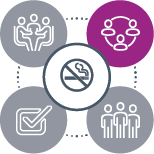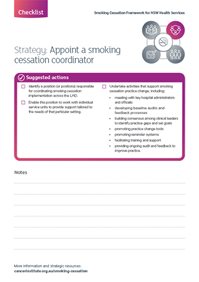Strategy: Appoint a smoking cessation coordinator

The NSW health system is complex and dynamic. Changing clinical practice requires focused and sustained effort.
Nationally and internationally, smoking cessation coordinators are used to deploy evidence-based smoking cessation systems of care across a range of clinical environments.
This is a critical element in enabling, establishing and maintaining practice change that local health districts (LHDs) may consider resourcing (either as an adjunct to an existing role or as a newly-formed role) to support the effective implementation of smoking cessation strategies.
The role of smoking cessation coordinators:
- Coordinate and lead smoking cessation strategies within services and across the LHD.
- Motivate staff within services to implement smoking cessation strategies.
- Disseminate information and education to support the integration of evidence-based smoking cessation strategies into clinical practice.
- Identify, promote and provide training.
- Act as trouble-shooting consultants to help staff adapt and implement interventions.
- Guide the collaborative development of local clinical protocols.
- Monitor, report and provide feedback on implementation progress (including in regard to key performance indicators and targets).
Success factor
Networking
Link clinical staff across the LHD to the relevant smoking cessation coordinator/s. Ensure that new staff know how to get in touch with them.
Tip: Include their contact details in strategic communications on smoking cessation.
 Suggested actions
Suggested actions
| Identify a position (or positions) responsible for coordinating smoking cessation implementation across the LHD. | |
| Enable this position to work with individual service units to provide support that is tailored to the needs of that particular setting. | |
Undertake activities that support smoking cessation practice change, including:
|

